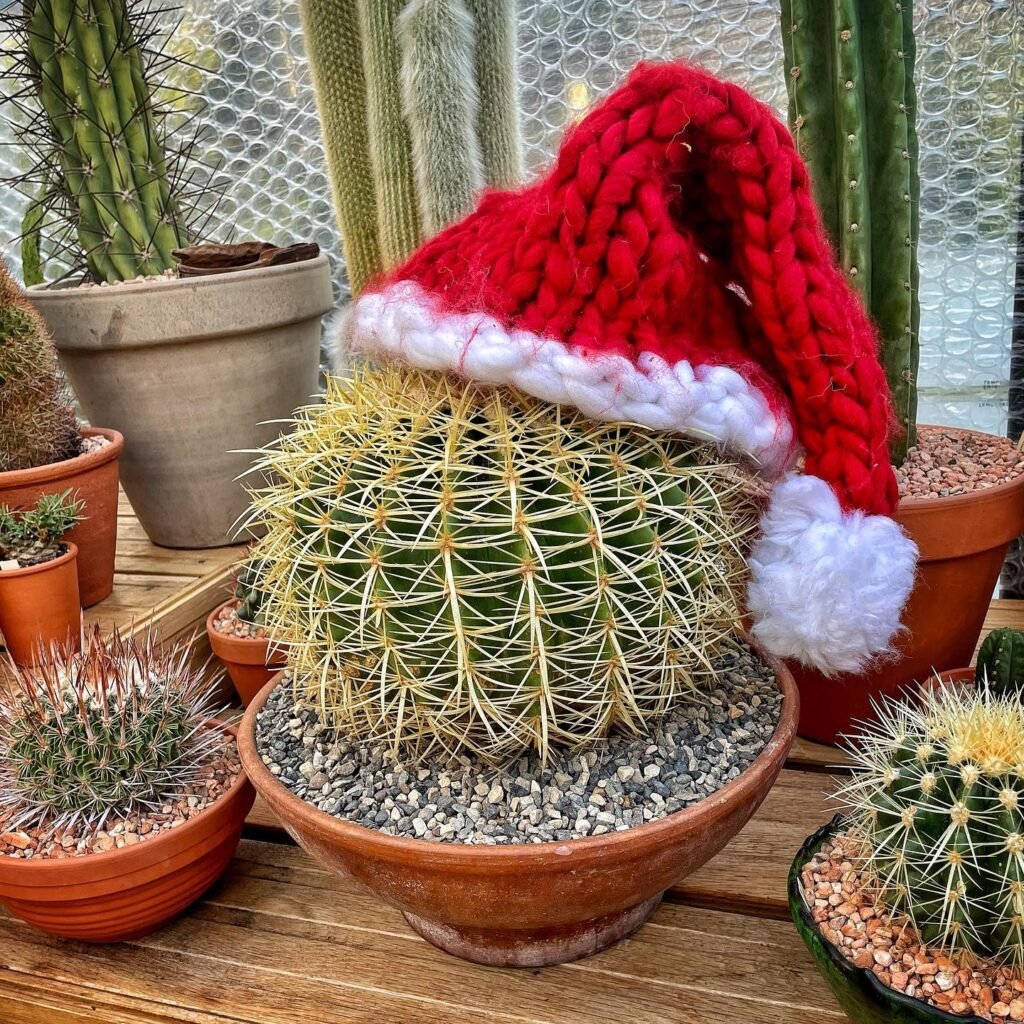Have you ever wanted to add a touch of desert beauty to your indoor space? Look no further than Echinocactus grusonii, also known as the Golden Barrel Cactus. This stunning succulent plant is not only a drought-tolerant and low-maintenance choice, but it can also thrive right here in the UK.
But how do you care for this golden ball of beauty? How can you ensure that it remains healthy and vibrant indoors? In this article, I will share expert tips on everything from light requirements and watering techniques to pruning and maintenance. Get ready to transform your space with the mesmerizing charm of the Golden Barrel Cactus. Let’s dive in!
Appearance of Echinocactus grusonii (Golden Barrel Cactus)


Echinocactus grusonii, also known as the Golden Barrel Cactus, has a unique and eye-catching appearance that sets it apart from other plants. Its round, barrel-shaped stem features deep ribs covered in creamy yellow spines, creating a spiky ball-like texture. The crown of the cactus is adorned with woolly white hairs, providing a soft and contrasting touch to its prickly exterior.
One of the standout features of Echinocactus grusonii is its occasional cup-shaped flowers. These vivid yellow blooms add a burst of color to the cactus, enhancing its beauty even further. With its distinctive appearance, this cactus has earned the nickname “mother-in-law’s cushion,” referencing its cushion-like shape and spiky nature.
 Did you know that the Echinocactus grusonii, or Golden Barrel Cactus, is often called the “Mother-in-Law’s Cushion“? This humorous nickname is inspired by its round shape and densely packed spines, suggesting it would make a rather uncomfortable seat!
Did you know that the Echinocactus grusonii, or Golden Barrel Cactus, is often called the “Mother-in-Law’s Cushion“? This humorous nickname is inspired by its round shape and densely packed spines, suggesting it would make a rather uncomfortable seat!
Light Requirements for Echinocactus grusonii
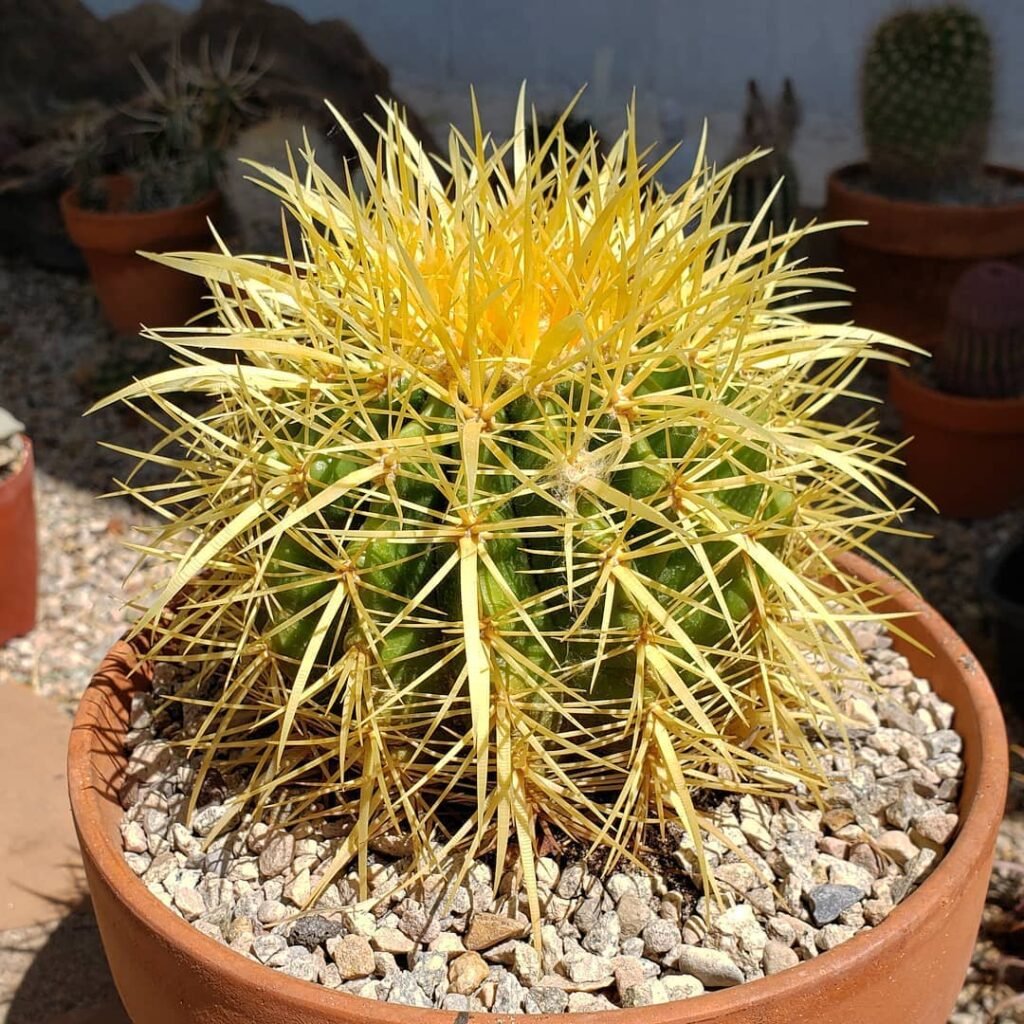
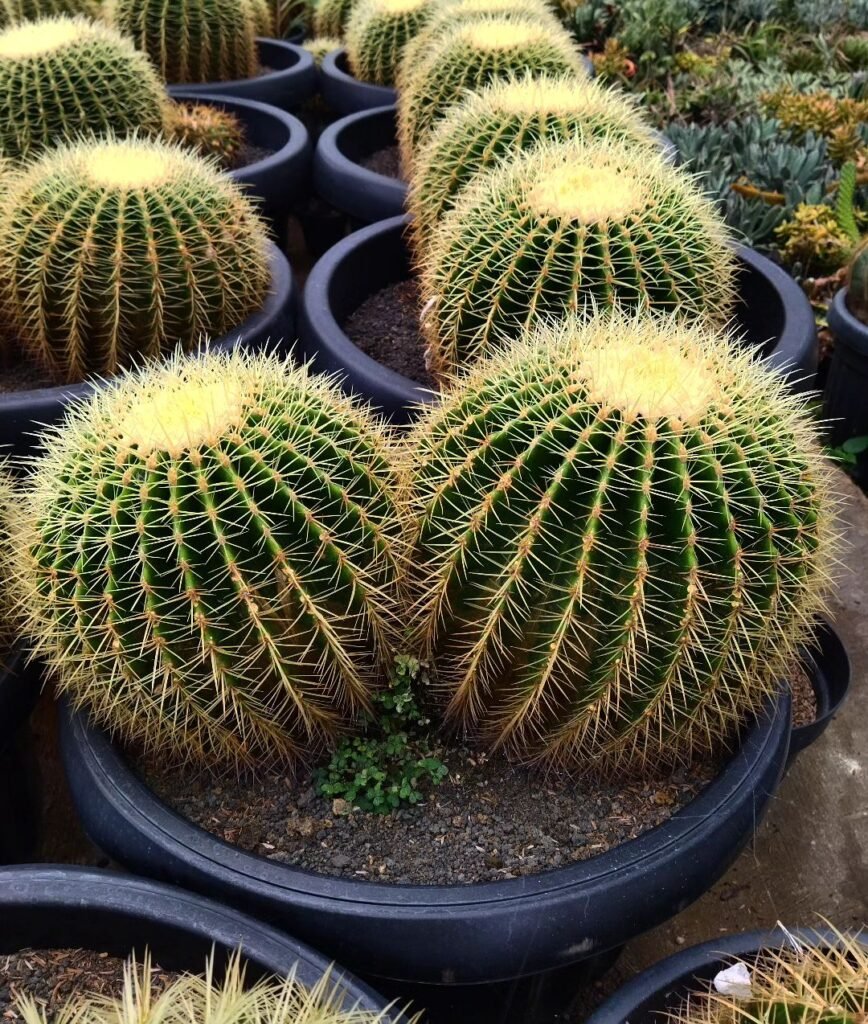
Echinocactus grusonii, also known as the Golden Barrel Cactus, requires abundant bright, indirect light to thrive. While it can tolerate some sun exposure, it’s important to avoid placing the cactus in direct sunlight as it can lead to scorched leaves and damage the plant.
For optimal growth and health, it’s best to find a location with a lot of bright indirect light, such as near a window that receives ample sunlight. This will provide the necessary light for the Golden Barrel Cactus without subjecting it to the risk of scorching.
If you’re unable to provide sufficient natural light, using artificial grow lights can be a suitable alternative. Make sure to choose lights that emit a spectrum similar to natural sunlight to support the cactus’s photosynthesis process.
Remember that Echinocactus grusonii is a desert-dweller and thrives in bright environments. So, finding the right balance of light will contribute to the overall health and appearance of your Golden Barrel Cactus.

Watering Tips for Echinocactus grusonii (Golden Barrel Cactus)
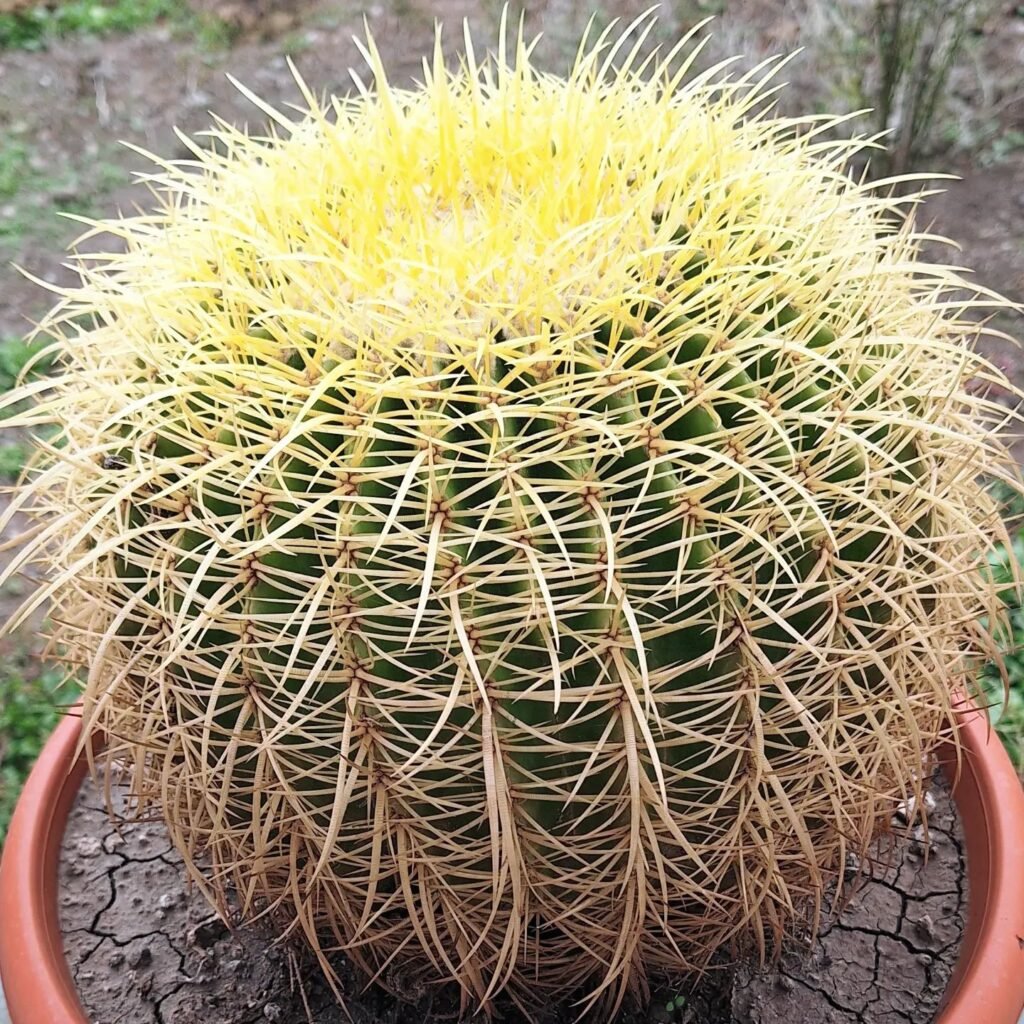

Proper watering is crucial for the health and well-being of the Echinocactus grusonii, commonly known as the Golden Barrel Cactus. To ensure optimal growth and prevent any potential issues, it is important to follow these watering tips:
- Allow the top layer of soil to dry out between waterings. The Golden Barrel Cactus is a desert-dweller, and it is important to replicate its natural habitat by providing periods of dryness. Before watering, check if the top layer of soil is completely dry to the touch. This helps prevent overwatering and the development of waterlogged roots.
- Avoid overwatering to prevent root rot. Excess water can lead to root rot, a condition where the roots become waterlogged and start to decay. This can severely damage the cactus and even lead to its death. It is crucial to provide only the necessary amount of water and avoid leaving the plant sitting in standing water.
- Adjust watering frequency during the summer months. During the warmer summer months, the Golden Barrel Cactus may require slightly more frequent watering due to increased evaporation and higher temperatures. However, it is important to exercise caution and still allow the soil to dry out between waterings. Monitor the moisture levels closely to avoid overwatering.

Fertilizing and Soil for Echinocactus grusonii


When it comes to caring for Echinocactus grusonii, fertilizing and providing the right soil are essential for its optimal growth and health. Here are some tips to ensure your Golden Barrel Cactus thrives.
Fertilizing Echinocactus grusonii
During the summer months, it is beneficial to fertilize your Echinocactus grusonii. Using a high potassium fertilizer can help promote healthy growth and encourage flowering. Look for a fertilizer specifically formulated for cacti and succulent plants, as these will have the right balance of nutrients to support your Golden Barrel Cactus.
Soil for Echinocactus grusonii
The Golden Barrel Cactus prefers well-draining soil that mimics its native desert environment. Opt for a cactus potting mix or a soil mix specifically designed for succulent plants. These types of soils provide the necessary drainage to prevent root rot and maintain the proper moisture levels for your Echinocactus grusonii.
When repotting your cactus, ensure that the new pot has drainage holes to allow excess water to escape. This will help prevent waterlogged roots, which can lead to rot and other issues. Remember, good drainage is key to keeping your Golden Barrel Cactus happy and healthy.
By regularly fertilizing with a high potassium fertilizer and using the right soil, you can provide your Echinocactus grusonii with the essential nutrients it needs to thrive and flourish. Keep in mind that moderation is key when fertilizing, as over-fertilization can harm the plant. Follow the instructions provided with the fertilizer and monitor the health of your cactus to ensure the best results.

Pruning and Maintenance for Echinocactus grusonii

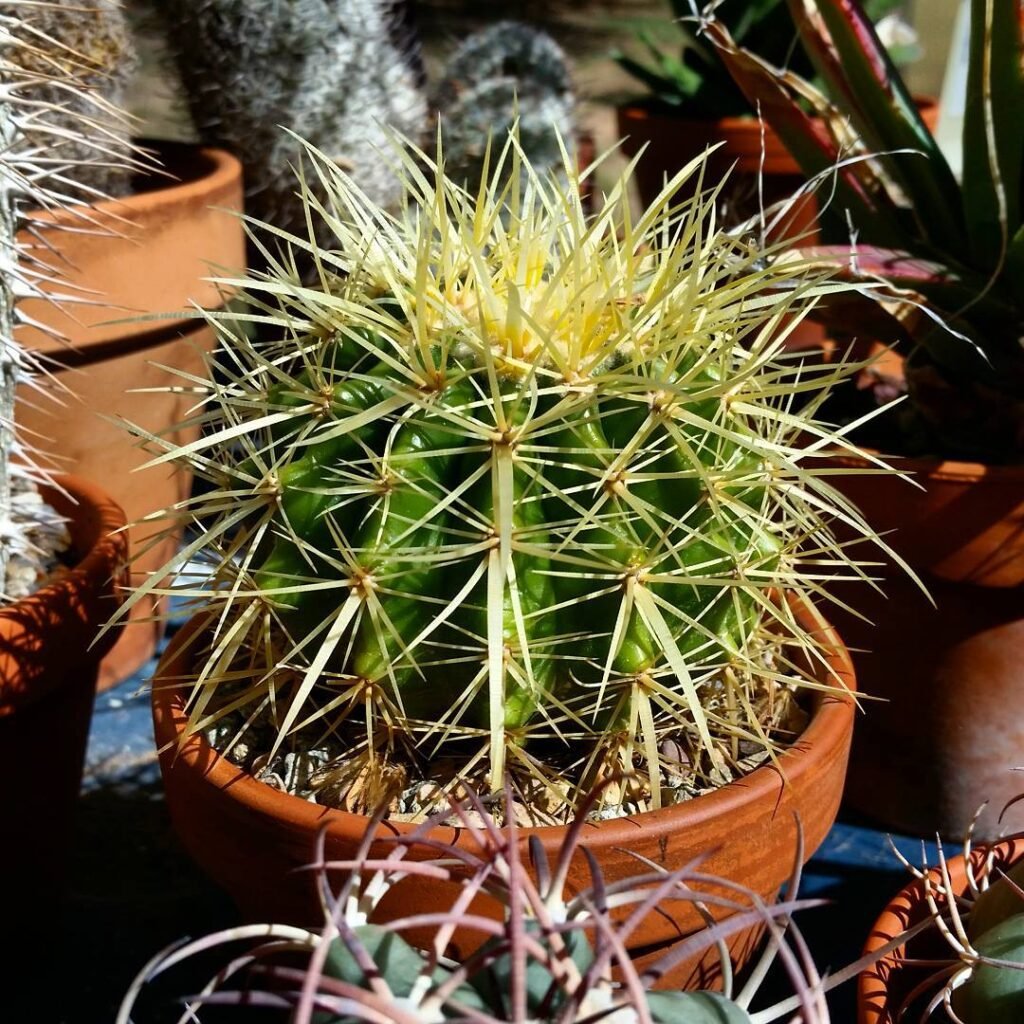
Pruning requirements for Echinocactus grusonii, commonly known as the Golden Barrel Cactus, are minimal. However, regular maintenance is crucial to ensure the health and appearance of this stunning succulent plant.
Inspecting the cactus regularly is important to identify and remove any dead or damaged spines. This not only maintains the plant’s aesthetics but also promotes its overall health.
When it comes to handling the Golden Barrel Cactus, caution is key due to the sharp spines. To avoid injuries, it is recommended to wear protective gloves or use a pair of tongs when working with the cactus.

Propagating Echinocactus grusonii (Golden Barrel Cactus)

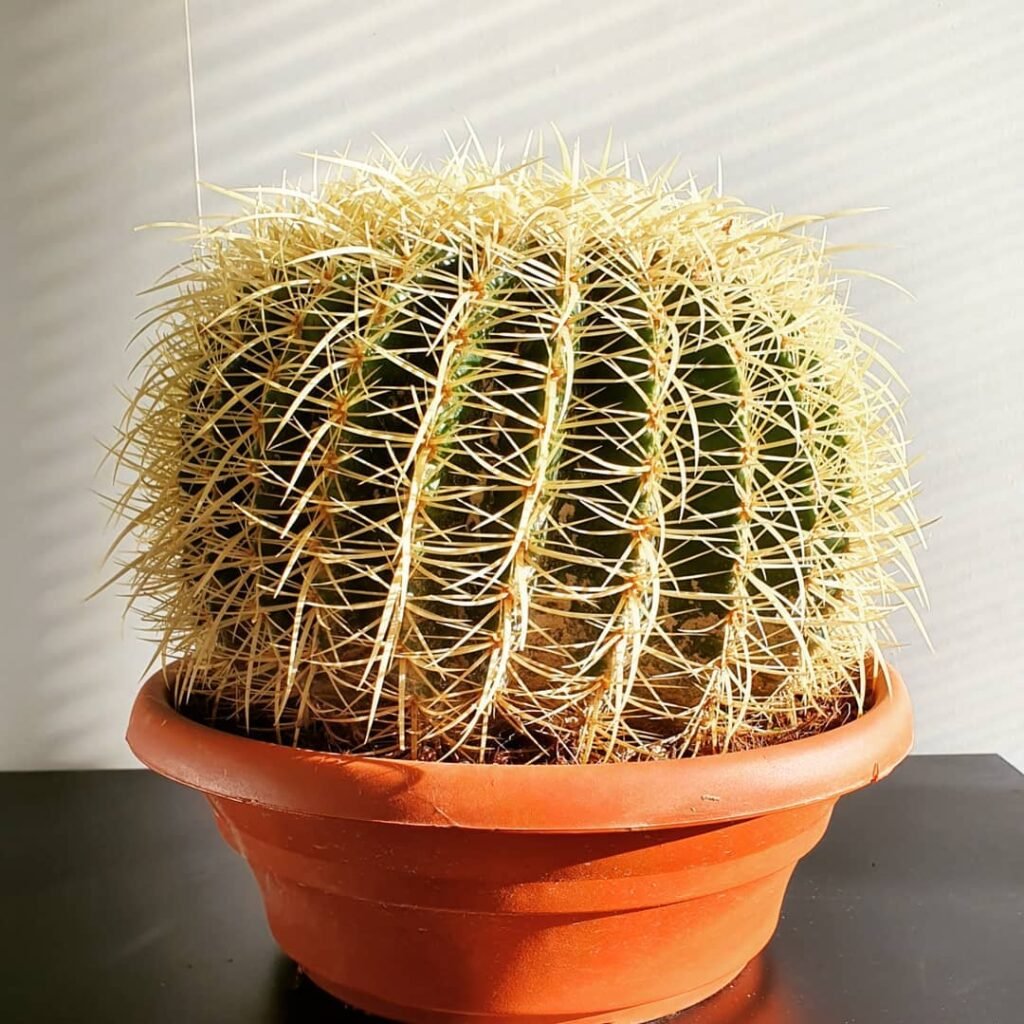
If you want to expand your collection of Echinocactus grusonii or share the beauty of the golden barrel cactus with others, propagation is a wonderful option. The process involves creating new individual cacti from offsets or pups, which are small offshoots that grow around the base of the parent plant.
- Carefully detach the offsets from the parent plant using a clean, sharp knife or scissors. Make sure to keep the roots intact.
- After detaching, set the offsets aside and allow them to dry and callus for several days. This step reduces the risk of rotting and helps promote successful rooting.
- Once the offsets have callused, inspect them for any signs of damage or disease and remove any affected areas.
- Prepare a well-draining potting mix suitable for cacti and succulents. Make sure the pot has drainage holes to prevent waterlogging.
- Plant the offsets in the potting mix, ensuring that the roots are well-covered but the base of the offset remains above the soil line.
- Water the newly planted offsets lightly, allowing the soil to dry out between waterings. This helps prevent overwatering and allows the roots to establish.
- (Optional) To further stimulate root growth, consider using a rooting hormone before planting the offsets. This can improve the success rate of propagation.
- Place the pot in a bright location with indirect sunlight and provide the appropriate care for young cacti, such as avoiding excessive watering and protecting them from extreme temperatures.

Repotting Tips for Echinocactus grusonii
Repotting Echinocactus grusonii, also known as the Golden Barrel Cactus, is typically not required frequently. However, if your cactus has outgrown its current pot and appears rootbound, it may be necessary to repot it to ensure its continued growth and health.
When repotting your Golden Barrel Cactus, choose a well-draining pot that is slightly larger than its current one. This will allow room for the cactus to spread its roots and thrive. A pot with drainage holes is essential to avoid waterlogging the roots, which can lead to root rot.
It is recommended to use a cactus mix or a soil specifically designed for desert plants when repotting Echinocactus grusonii. These types of soils provide the necessary drainage for the cactus and mimic its natural habitat. Avoid using regular potting soil, as it may retain too much moisture.
When it comes to repotting frequency, it is important to assess the condition of your cactus and its potting situation. Repotting every two to three years is generally sufficient, or whenever the cactus has outgrown its pot or appears rootbound.
During the repotting process, it is crucial to handle the Golden Barrel Cactus with care to avoid damaging its sensitive root system and spines. You may want to wear protective gloves or use a pair of tongs for safe handling. Take the time to gently remove the cactus from its old pot and place it into the new pot, ensuring that the roots are well-positioned and covered with soil.
 Did you know the Echinocactus grusonii, or Golden Barrel Cactus, can live over 50 years? Its ability to store water lets it thrive in harsh deserts.
Did you know the Echinocactus grusonii, or Golden Barrel Cactus, can live over 50 years? Its ability to store water lets it thrive in harsh deserts.
Toxicity of Echinocactus grusonii
Echinocactus grusonii, commonly known as the Golden Barrel Cactus, is non-toxic to humans and pets. However, it is important to handle this cactus with caution due to its sharp spines. Mishandling the Golden Barrel Cactus can result in discomfort or injuries. To ensure safe handling, it is recommended to wear protective gloves or use proper tools when necessary.
By taking proper precautions, such as wearing gloves and using tools, you can enjoy the beauty of the Golden Barrel Cactus without any harm. Remember to always handle this cactus with care!
Additional Tips for Caring for Echinocactus grusonii
In addition to the specific care instructions mentioned above, here are some additional tips for successfully caring for Echinocactus grusonii. This cactus is a desert-dweller and thrives in temperatures between 10-27°C. It is important to keep the cactus away from cold draughts that can cause temperature fluctuations, as they prefer a stable environment.
Echinocactus grusonii also prefers drier air, so it is best to avoid placing it in areas with high humidity, such as bathrooms or kitchens. Providing bright indirect light is crucial for its growth. Placing the cactus near a window that receives ample sunlight throughout the day will ensure it receives the proper amount of light without being exposed to direct sunlight, which can lead to leaf scorching.
Proper watering habits are essential for the health of the Golden Barrel Cactus. Remember to let the top layer of soil dry out between waterings to prevent root rot. It is better to underwater than overwater, as excess water can damage the roots. Using a well-draining soil mix specifically designed for cacti and succulents will help maintain proper moisture levels and prevent waterlogging.
By following these care tips, including maintaining optimal temperature, avoiding high humidity, providing bright indirect light, and practicing proper watering habits, you can create an ideal environment for Echinocactus grusonii to thrive. Enjoy the beauty and unique characteristics of this stunning desert plant.
Helpful Videos about Echinocactus grusonii (Golden Barrel Cactus)
Have a look at these brilliant videos I’ve discovered, focusing on the care of Echinocactus grusonii, or the Golden Barrel Cactus. They’re filled with tips to make caring for your cactus a breeze, truly simplifying the process. Ideal for anyone eager to start their journey into gardening!
- GOLDEN BARREL CACTUS Information and Growing Tips! ( Echinocactus grusonii)
- How I take care of cactus Echinocactus grusonii
- HOW TO GROW ECHINOCACTUS GRUSONII FROM SEEDS? | Barrel cactus propagation
FAQ about Echinocactus grusonii (Golden Barrel Cactus)

Seeking guidance on caring for your Echinocactus grusonii, the renowned Golden Barrel Cactus? You’re in the perfect spot! I’ve prepared a handy set of FAQs to support you in nurturing your cactus with ease. Discover the essentials of watering, sunlight requirements, and how to safely handle its spines. Your journey to becoming a confident cactus carer starts here.
The Golden Barrel Cactus, or Echinocactus grusonii, is a round, green cactus famed for its striking golden-yellow spines, resembling a barrel.
Yes, but with caution. The UK’s climate can be too cold and wet for this desert plant. It thrives outdoors in summer but should be brought inside or protected during cold, wet winters.
It loves sunlight! Place it in a spot where it can bask in direct sunlight for most of the day, especially in the less sunny UK climate.
Use a well-draining cactus mix or create your own with one part potting soil, one part coarse sand, and one part perlite.
Water sparingly. Allow the soil to completely dry out between waterings. In the UK, this might mean watering less frequently, especially during cooler months.
Yes, but sparingly. Feed it with a cactus-specific fertiliser during the growing season (spring and summer) once a month.
Carefully repot it in the spring, every 2-3 years, or when it outgrows its pot. Use gloves to handle it and a pot just slightly larger than the cactus.
This could be due to sunburn or water stress. Ensure it’s not in too harsh sunlight and that you’re watering correctly.
It prefers temperatures between 15°C and 30°C. Protect it from frost and prolonged temperatures below 10°C.
Yes, with adequate care and plenty of sunlight, mature plants can produce yellow flowers in the summer.
Keep an eye out for mealybugs and spider mites. Treat promptly with insecticide or neem oil if you spot these pests.
Yes, but it’s a slow process. Sow seeds in a well-draining soil mix and keep warm and moist until germination.
Always wear thick gloves when handling your cactus to protect yourself from its sharp spines.
While it’s possible, it’s best to pair it with plants that have similar sunlight and water needs. Consider other cacti or succulents for a harmonious arrangement.
Yes, it can be normal for Echinocactus grusonii to lean towards the sun, especially if it’s not getting even light exposure. Rotate your cactus periodically to encourage even growth.
The Golden Barrel Cactus isn’t toxic to pets, but its sharp spines can cause injuries if pets try to bite or paw at it. It’s wise to place the cactus where pets can’t reach it to avoid any accidents.
Yes, the Golden Barrel Cactus is known for its slow growth rate, especially in the cooler UK climate. Ensure it’s receiving enough sunlight and being watered properly, but patience is key with this plant.
I hope this FAQ has made things a bit clearer on how to look after your Echinocactus grusonii, or Golden Barrel Cactus. If you’ve still got questions, don’t be shy to drop them in the comments. I’m here to lend a hand. Remember, we all start from the beginning with plants, and there’s always something new to discover as you grow alongside your spiky friend.

